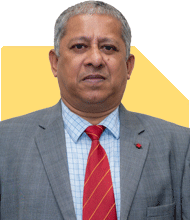I'm 37, paid off 90L loan. Retire by 46? How much?
Ramalingam Kalirajan |9252 Answers |Ask -Follow
Mutual Funds, Financial Planning Expert - Answered on Jun 03, 2025
He has an MBA in finance from the University of Madras and is a certified financial planner.
He is the director and chief financial planner at Holistic Investment, a Chennai-based firm that offers financial planning and wealth management advice.... more
.jpg)
Dear sirs, I am a 37 year old software engineer currently earning about 2L per month. I had home loan of about 90L which I have closed in 7 years with regular prepayments from bonuses and savings I did. I currently own about 45L invested in mutual funds and stocks. I have a wife who is working and a daughter starting school in a month. I wanted to know what would be the savings or corpus required i would have to retire in 8 -9 years? and where would my maximum investment focus be on?
Repaying a Rs. 90 lakh home loan in just 7 years shows your financial commitment.
It gives you freedom to plan your future goals with peace.
You are 37 now and want to retire in 8 to 9 years.
That puts your retirement goal around age 45 or 46.
It is achievable with structured investing and smart planning.
Now let us do a 360-degree evaluation of your situation.
CURRENT FINANCIAL SNAPSHOT
Age: 37 years
Monthly Income: Rs. 2,00,000
Spouse: Working professional
Child: Daughter starting school
No liabilities now, home loan closed
Assets: Rs. 45 lakh in mutual funds and stocks
LIFESTYLE EXPENSES POST RETIREMENT
You should target monthly income of at least Rs. 1,20,000 in today’s value
After 8 to 9 years, this amount will increase due to inflation
You need to plan for at least 40 years of retired life
Retirement corpus must beat inflation and provide monthly income
KEY GOALS TO BE FUNDED
Retirement at age 45 or 46
Higher education and marriage of daughter
Contingency planning for medical or family emergencies
Vacation or hobby-based lifestyle post retirement
EVALUATION OF EXISTING PORTFOLIO
Rs. 45 lakh in mutual funds and stocks is a good start
Avoid direct stocks unless you have time to study them regularly
Mutual funds give diversification and professional management
If you are in direct mutual funds, avoid them
Direct plans lack advisor support during volatility
Better to invest in regular funds through Mutual Fund Distributor with CFP credential
Avoid index funds – they are passive and don't adapt to market cycles
Actively managed funds adjust allocation based on market trends
Regular funds also offer rebalancing support from the Certified Financial Planner
This helps in long-term goal-based investing
INSURANCE PROTECTION ANALYSIS
Check if you have term life cover of at least Rs. 1.5 crore
You have dependents – wife and daughter
In your absence, they need sufficient financial protection
Buy term plan if you haven’t already
Avoid ULIP and traditional insurance plans for investments
Insurance is only for protection, not for returns
Also take health insurance for self, spouse, and daughter
Employer health cover will stop when you retire early
Take personal health cover before that
Choose a policy with Rs. 10-15 lakh cover
Also add super top-up for enhanced coverage at low cost
Consider personal accident insurance as well
MONTHLY SAVINGS TARGET FROM NOW
You have around 8 to 9 years to retire
Your current portfolio value is Rs. 45 lakhs
That is a strong base, but not sufficient for early retirement yet
You should save aggressively now
You are earning Rs. 2 lakh monthly – try to save Rs. 75,000 to Rs. 1 lakh every month
Invest this across equity mutual funds and hybrid funds
Increase SIPs with each salary hike or bonus
Also invest lump sum in a phased manner whenever you receive windfalls
WHERE TO FOCUS INVESTMENTS GOING FORWARD
65% to 70% in equity mutual funds till retirement
Use actively managed diversified equity mutual funds
Avoid index funds due to lack of downside protection
Avoid direct funds as they give no support during market corrections
20% to 25% in hybrid and short-term debt funds for stability
5% to 10% in liquid funds or ultra short-term funds for emergency
5% in gold through Sovereign Gold Bonds or mutual fund route
Avoid buying physical gold or jewellery for investment
ASSET ALLOCATION STRATEGY UNTIL AGE 45-46
Equity mutual funds: 65% (multi-cap, flexi-cap, large and mid cap)
Hybrid funds: 20% (balanced advantage, equity savings type)
Debt funds: 10% (short-term and liquid funds)
Gold and PPF: 5% (not more)
Rebalance once every year with support from a CFP-certified advisor
Stay in regular plans managed through an MFD
They help in adjusting portfolio as per market and goal shifts
CORPUS REQUIRED TO RETIRE AT AGE 45-46
You will need a large corpus to last for 40+ years post-retirement
For Rs. 1,20,000 per month income (today’s value), your future monthly need will be more
Your corpus must be inflation-adjusted
You should target at least Rs. 4 to 5 crore corpus by 45-46
This includes retirement needs and daughter’s education
Corpus can generate monthly income using Systematic Withdrawal Plans (SWP)
RETIREMENT STRATEGY POST AGE 46
Start monthly withdrawals through SWP from mutual funds
Keep 2 years’ worth of expenses in debt or liquid funds
Balance corpus should stay in equity for growth
Maintain equity exposure of 40% to 50% even after retirement
Rest can be in debt mutual funds for stability
Rebalance every year based on market conditions and inflation
Work with a CFP to manage post-retirement portfolio
Avoid annuities – returns are low, taxable, and rigid
Also avoid FD-based income – taxable and low interest
CHILD’S EDUCATION AND FUTURE GOALS
Create a separate SIP for child’s education
Long-term SIP in child-oriented or multi-cap equity funds
Don’t mix education fund with your retirement goal
Marriage can be planned from bonus or other windfalls
Education is the priority, so start that SIP soon
Use mutual funds only, not insurance-cum-investment schemes
ESTATE AND LEGACY PLANNING
Create a simple Will for asset distribution
Add nominees to all mutual funds and bank accounts
Keep financial documents organised and accessible to your spouse
Discuss financial plans with your wife regularly
Educate her on how your investments work
Include joint names in key accounts and assets
Plan now so family faces no issues later
ADDITIONAL TIPS TO SPEED UP EARLY RETIREMENT GOAL
Avoid lifestyle inflation – don’t increase spending with income rise
Redirect every bonus, gift, or surplus towards investments
Increase SIP every year by 10-15%
Avoid unnecessary loans or high-cost EMIs
Travel or luxury expenses should not affect goal investments
Set your goal visually – track corpus target quarterly
Take annual guidance from a Certified Financial Planner
Their unbiased advice helps you stay focused and confident
TAX PLANNING & NEW MF TAX RULES
When you sell equity mutual funds:
Long-term capital gains above Rs. 1.25 lakh are taxed at 12.5%
Short-term capital gains are taxed at 20%
For debt mutual funds: Both long and short-term gains are taxed as per your income tax slab
Do tax harvesting if required in March
Invest with tax-efficiency in mind
Avoid locking all money in taxable fixed income products
DON’T DO THESE MISTAKES
Don’t invest in ULIPs or traditional LIC policies
They don’t create wealth or give enough cover
Don’t put money in annuities – rigid and poor returns
Don’t rely on stock tips or friends’ advice
Don’t park large money in savings or FDs
Don’t ignore inflation in your planning
Don’t stop SIPs during market corrections
Don’t invest in index funds – they lack active management and protection in downturns
FINALLY
You are financially disciplined and goal-oriented
Clearing Rs. 90 lakh loan in 7 years is a major achievement
Now focus fully on creating long-term wealth
Invest only in mutual funds via regular route through a CFP-guided MFD
Avoid distractions like ULIPs, annuities, index funds, and direct funds
Build a separate education fund for your daughter
Target Rs. 4 to 5 crore for early retirement
Invest every month, increase SIPs yearly, and track progress quarterly
Work closely with a Certified Financial Planner who knows your goals
Your early retirement at 45-46 is not only possible, it is very much practical
Best Regards,
K. Ramalingam, MBA, CFP,
Chief Financial Planner,
www.holisticinvestment.in
https://www.youtube.com/@HolisticInvestment
You may like to see similar questions and answers below
Ramalingam Kalirajan |9252 Answers |Ask -Follow
Mutual Funds, Financial Planning Expert - Answered on Oct 26, 2023
Ramalingam Kalirajan |9252 Answers |Ask -Follow
Mutual Funds, Financial Planning Expert - Answered on Jul 17, 2024
Ramalingam Kalirajan |9252 Answers |Ask -Follow
Mutual Funds, Financial Planning Expert - Answered on Sep 04, 2024
Ramalingam Kalirajan |9252 Answers |Ask -Follow
Mutual Funds, Financial Planning Expert - Answered on Sep 11, 2024
Milind Vadjikar | Answer |Ask -Follow
Insurance, Stocks, MF, PF Expert - Answered on Nov 03, 2024
Nayagam P P |7124 Answers |Ask -Follow
Career Counsellor - Answered on Jun 27, 2025
Nayagam P P |7124 Answers |Ask -Follow
Career Counsellor - Answered on Jun 27, 2025
Nayagam P P |7124 Answers |Ask -Follow
Career Counsellor - Answered on Jun 27, 2025
Prof Suvasish Mukhopadhyay |1826 Answers |Ask -Follow
Career Counsellor - Answered on Jun 27, 2025
Samraat Jadhav |2356 Answers |Ask -Follow
Stock Market Expert - Answered on Jun 27, 2025
Nayagam P P |7124 Answers |Ask -Follow
Career Counsellor - Answered on Jun 27, 2025
Nayagam P P |7124 Answers |Ask -Follow
Career Counsellor - Answered on Jun 27, 2025
Nayagam P P |7124 Answers |Ask -Follow
Career Counsellor - Answered on Jun 27, 2025
Nayagam P P |7124 Answers |Ask -Follow
Career Counsellor - Answered on Jun 27, 2025
Nayagam P P |7124 Answers |Ask -Follow
Career Counsellor - Answered on Jun 27, 2025




















